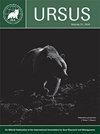加强黄石灰熊的种群监测
IF 0.8
4区 生物学
Q4 ZOOLOGY
引用次数: 1
摘要
摘要:在大黄石生态系统中,通过系统的航空调查和机会性的地面观测,结合人口统计数据,得出了每年有幼崽的雌性灰熊(Ursus arctos)的数量。我们解决了监测方法的两个限制。作为规则集的一部分,目前使用>30公里的保守距离作为阈值,将目击事件分配给具有幼崽的唯一雌性,导致低估偏差。利用1997-2019年期间收集的带幼崽的母熊遥测位置,我们为模拟带幼崽的母熊数量的5个级别创建了1000个数据集,通过在这些位置中进行选择来模拟目击,并评估了替代距离标准(12-30公里)的分类性能。在所有场景下,12 - 16 km标准最大限度地提高了分类性能,最小化了估计偏差;对于目前的条件和采样工作来说,16公里标准是最佳的。我们的第二个目标是测试广义加性模型(GAMs)作为一种灵活的趋势分析技术。我们模拟了10种情景中的1000个时间序列(在5年、10年和15年期间下降10%、15%和20%,加上稳定性),应用GAMs,并评估了与瞬时变化率的后验分布相关的指标。在下降15%和20%的情况下,我们检测到>99.6%的重复出现下降,在下降10%的情况下,84.7% - 94.7%的重复出现下降。从发病到首次检测,周期从3.7(5年内下降20%)到11.1(15年内下降10%)不等,检测事件的平均持续时间为3.9-8.8年。GAM方法可以检测人口趋势的方向性变化,包括早期预警指标,并在这种变化后保持稳定。回顾性应用16公里距离标准和GAMs得出的人口估计值和增长率高于使用当前方法报告的结果。本文章由计算机程序翻译,如有差异,请以英文原文为准。
Enhancements to population monitoring of Yellowstone grizzly bears
Abstract: In the Greater Yellowstone Ecosystem, counts of female grizzly bears (Ursus arctos) with cubs-of-the-year (females with cubs) from systematic aerial surveys and opportunistic ground sightings are combined with demographic data to derive annual population estimates. We addressed 2 limitations to the monitoring approach. As part of a rule set, a conservative distance of >30 km currently is used as a threshold to assign sightings to unique females with cubs, resulting in underestimation bias. Using telemetry locations of females with cubs collected during 1997–2019, we created 1,000 data sets for each of 5 levels of simulated number of females with cubs, simulated sightings by selecting among these locations, and evaluated the classification performance of alternative distance criteria (12–30 km). Under all scenarios, 12–16-km criteria maximized classification performance and minimized estimation bias; the 16-km criterion was optimal for current conditions and sampling efforts. Our second objective was to test generalized additive models (GAMs) as a flexible trend analysis technique. We simulated 1,000 time series for each of 10 scenarios (10, 15, and 20% decline over periods of 5, 10, and 15 yrs, plus stability), applied GAMs, and assessed metrics associated with the posterior distribution of the instantaneous rate of change. We detected declines among >99.6% of replicates under the 15 and 20% decline scenarios and in 84.7–94.7% of replicates under the 10% decline scenario. From decline onset to first detection, periods ranged from 3.7 (20% decline over 5 yrs) to 11.1 (10% decline over 15 yrs), with 3.9–8.8 years mean duration of detection events. The GAM approach allows detection of directional changes in population trend, including early warning metrics, and stabilization after such changes. Retrospective application of the 16-km distance criterion and GAMs resulted in higher population estimates and growth rates than are reported using current methods.
求助全文
通过发布文献求助,成功后即可免费获取论文全文。
去求助
来源期刊

Ursus
生物-动物学
CiteScore
2.00
自引率
15.40%
发文量
12
审稿时长
>12 weeks
期刊介绍:
Ursus includes a variety of articles on all aspects of bear management and research worldwide. Original manuscripts are welcome. In addition to manuscripts reporting original research, submissions may be based on thoughtful review and synthesis of previously-reported information, innovative philosophies and opinions, and public policy or legal aspects of wildlife conservation. Notes of general interest are also welcome. Invited manuscripts will be clearly identified, but will still be subject to peer review. All manuscripts must be in English. All manuscripts are peer-reviewed, and subject to rigorous editorial standards.
 求助内容:
求助内容: 应助结果提醒方式:
应助结果提醒方式:


